Japan has fantastic natural landscapes and breathtaking views. Japanese people are proud of these natural sceneries and use different ways to show their affection.
A traditional way to highlight the beauty of the country is by bonkei or a three-dimensional “tray landscape.”
Bonkei is a temporary or permanent depiction of a natural landscape. It is created using dry materials such as rock, cement mixtures, papier-mache, and sand.
This traditional art form is different from a bonseki in such a way that bonseki depicts a landscape that looks flat and simple. Bonseki is saved for viewing for days, weeks or months until the piece is erased to make another piece.
On the other hand, bonkei uses dry materials to make a miniature representation of a landscape. Bonkei can depict a mountainside, an island, a small community, a farm and so on.
Is a bonkei better than a bonseki? It depends on your preference. But if you want to make a specific representation of an area and not just a dramatic representation then a bonkei is better.
What is Bonkei?
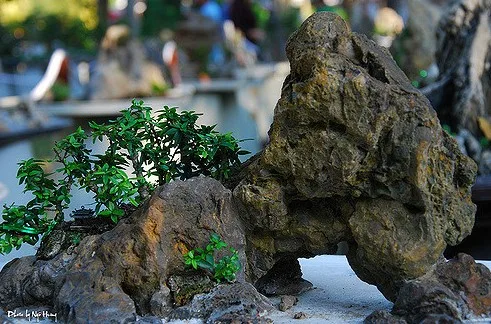
Image Source: Flickr
Bonkei can be a temporary or a permanent depiction of a landscape in miniature form. This art form does not contain any living material, unlike bonsais or bonseki.
A bonkei may be compared to a diorama where a landscape, building or place is depicted in three-dimensional form.
The goal of bonkei is to create an aesthetically-pleasing model that can be used as a display or a representation. Compared to a bonseki, a bonkei is depicted on a wide and low-sided tray.
Should there be river banks, mountains or hills in the bonkei, these are created using materials used for sculpting such as clay, cement, papier mache and so on.
The components of the bonkei that are sculpted out of the mentioned materials are painted according to the color of the environment.
Meanwhile, depicting flat land or flat water on a bonkei is done by using colored sand particles or gravel for dark components. A bonkei creator may also use real rocks if needed.
Using figurines on bonkei
There are some bonkei creators that use miniature lifelike figures of animals and humans on their work. Realistic structures such as temples and sculptures, vehicles and signs may also be used.
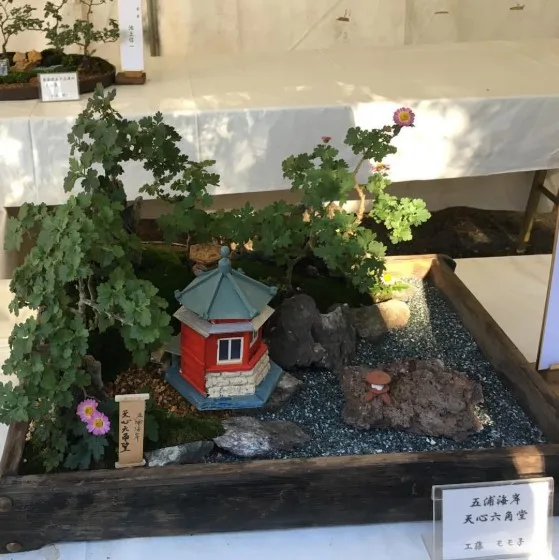
Image Source: PicBon
Model trees and fake vegetation may also be used. Live plants such as bonsai are not a part of bonkei and these are not used. When a bonkei is finished, this may be displayed in a glass case or a transparent case on top of a table or pedestal.
Bonkei projects may be displayed in homes or in businesses. Some works of renowned bonkei artists are found in museums and galleries.
Usually, bonkei needs an uncluttered background so that the project has the user’s undivided attention.
Where did Bonkei come from?
The practice of creating bonkei was derived from saikei or a plant landscape. It is said to be from the Chinese penjing and the Vietnamese form called Hòn Non Bộ. But the main difference of bonkei is to use only artificial materials.
Bonkei has been used by people from different generations, to represent different sceneries and landscapes.
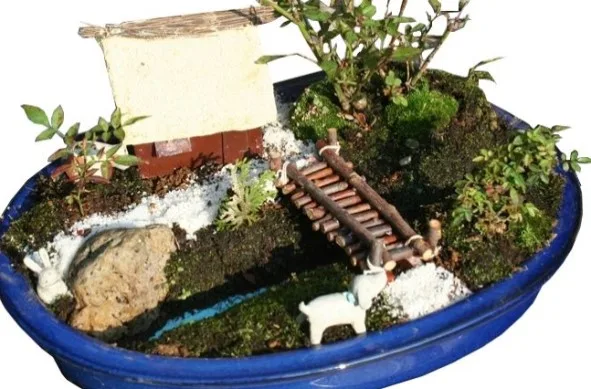
Image Source: Incredible Art Department
And because bonkei uses only dry materials, this arrangement can last for a long time or as long as no one messes with your project!
Meanwhile, arrangements like bonseki and bonsai need regular maintenance especially if a natural material like plants is used in the arrangement.
How to add Bonkei in your garden?
Since you can’t add a bonsai in a bonkei because bonsai is a living, growing plant. To use bonkei in your bonsai garden, you may add a bonkei piece as a centerpiece in your garden.
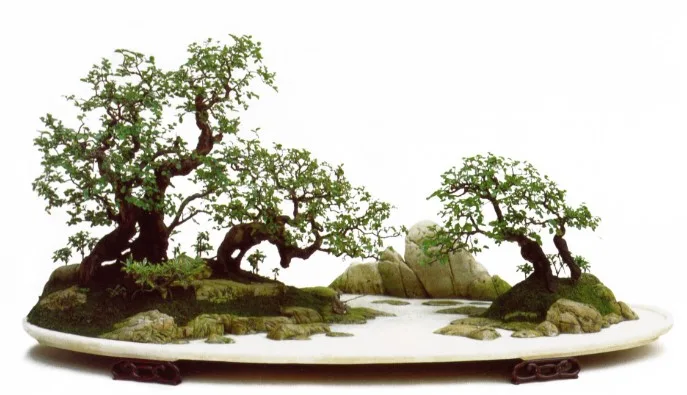
Image Source: Nixon Bonsai
And just like other similar art forms, you need to spend time, money and effort to make a bonkei. Here are things you will need to make this simple seashore bonkei project.
Things you’ll need
- A pattern or design of your project
- A large tray to hold your bonkei
- Styrofoam
- Hot glue, glue gun
- Old newspaper
- Poster paint
- Brushes
- Miniature models
Instructions
- Sketch your design on paper. This is a seashore bonkei project so draw a serene shore with waves cascading along the beach.
- Take the tray and measure the base of the tray. Cut a large Styrofoam to fit the base. Use hot glue to stick the Styrofoam to the base.
- Use remaining Styrofoam to make elevated portions of your shoreline bonkei. Use these to make lifelike cliffs, mountain ranges, and other structures. Secure everything with wooden pegs and some glue.
- Use papier mache to improve the structure of the bonkei. When you are done, allow everything to dry before applying poster paint.
- When applying paint, apply one layer at a time. Use a combination of colors for a realistic look.
- Add fake foliage and trees along the shore. Add miniature structures like people, huts, boats, animals and more. You may simply stick these miniature models to the soft Styrofoam or you may use glue to secure these on the foam.
- When you’re done, place the bonkei inside a glass viewing case or transparent plastic cover. If you plan to keep the bonkei longer, secure all the materials with glue or wire.
A few tips when using bonkei
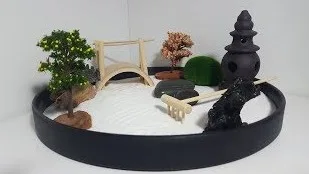
Image Source: WikiVisually
There is a tendency to go overboard when creating bonkei. You might be tempted to add more foliage, to enhance the color of the different components of the bonkei or to add more miniature structures.
Do not do this! The simpler the design, the better and the more impressive your bonkei will be.
When making bonkei designs, add as much detail as you can about the project. To save money, use recyclable materials for your project. You can use old newspaper for papier mache, old Styrofoam because you only needed a few pieces. It would be a waste to purchase a large one.
Bonkei is a way to represent a natural landscape. But take care not to overdo it. Simplicity is still key to making bonkei.


